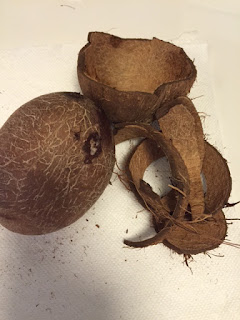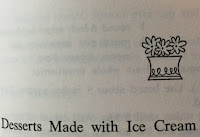Japanese Fruit Cake is the traditional Christmas cake for my mother's side of the family, though it is not a fruitcake. Come to think of it, I am not even sure why it is claimed to be Japanese. But I won't question tradition because it is absolutely one of my favorite cakes; spicy, buttery, fruity and rich. I don't remember celebrating a Christmas without it. I even have a Japanese Fruit Pie recipe, containing all of the same fruits and flavors, that is nearly as good.
The cake contains two layers of plain butter (1-2-3-4) cake alternated with two layers of spice cake containing allspice, cinnamon, cloves and raisins "chopped fine." In between the layers is a lemon and coconut filling which requires natural coconut.
 |
| Alternating layers with filling |
The recipe calls for "1 good-sized cocoanut, grated." Natural coconut is perfect because it is not pre-sweetened like commercial, flaked coconut, so the filling is not overly sweet. However, opening a coconut, peeling, then grating the meat is a chore. There were a couple of years in the 1990s when Mom and I couldn't find nary a coconut in the grocery stores...
One year, we had to buy three coconuts in three different trips to three different stores. First, we searched several stores, finding no coconuts. Then, each time we found one that sounded good, i.e. heavy and sounding sloshy-full of coconut water, we took it home, cracked it, and found the meat moldy, smelly or both. That year we gave up and bought flaked coconut and were able to finish the cake in time for Christmas. The next year the same thing happened on our first attempt to find a suitable coconut, so we gave-in to the flaked stuff and cut our losses. Ever since then, the prospect of buying a coconut at Christmas becomes a catalyst for much well-wishing, many prayers, and crossed fingers.
These days, I think that more people cook with natural coconut. Plus, I live in an area of town with a large Asian community, so I was pretty confident in my ability to find a decent specimen. I found one at my neighborhood grocery on my first attempt and it turned out to be a winner. The way Mama Judy cracked a coconut was to drive an ice pick into two or three of the eyes of the coconut to poke holes to the center, and then turn it eyes-down on a glass and leave it to drain. Keith had his drill in the house for another job, so with a clean drill bit we created the holes. No stabbing required. I then placed the drained coconut in a hot oven (about 400 degrees) and checked on it every few minutes. The heat caused the cocoa-brown hard shell to crack. After removing the shell, the thin brown inner shell could be removed with a vegetable peeler revealing the gorgeous white nut meat.

In most cases the nut meat cracks along with the outer casing, but this time, it came out whole like a big, sweet, oily pearl. I stood back and looked at it for a few minutes; it seemed almost a shame to cut it up and grate it. Although, maybe I was just dreading the grating.
There is nothing more dangerous to the skin on one's knuckles than having to grate coconut. The grating was always one of my jobs during the cake baking when I was little. This kid greased the pans with butter, cut the wax paper circles for the bottoms of the pans, dredged the raisins with flour, and grated the coconut. I grew up with both a respect and a fear of the box grater. If the cakes hadn't always been such a delicious reward for the dangerous work, I might have been terrified by the grater into adulthood.
It has been years since I have made a Japanese Fruit Cake on my own. Mom usually makes it at her home and brings it over on Christmas day. When my mom gave me a copy of
Southern Cooking by Mrs. Dull for Christmas 1989, she had written helpful advice on page 231, the Japanese Fruit Cake recipe. Her notations told me how long to bake the cakes, how much juice a lemon is expected to yield, and how to tell when the filling is the right consistency. Mom always used the filling as the frosting on the outside of the cake. I made the filling according to Mrs. Dull, but I ended up with only enough filling to go between the layers. Mom had forgotten to note in my book that the recipe needed doubling. I didn't have another coconut prepared to make more filling at the last minute.
Mrs. Dull's recipe instructed to cover the cake with white icing. Seven minute frosting would be too sweet, and I knew that Autumn liked the spice cake layers with Universal White Frosting. The Universal White Frosting recipe is from
Stressed is Just Desserts Spelled Backwards by Sheryl Meddin and Bennett Frisch (see Myers's Rum Cake, November 7). It is an amalgam of buttercream and cream cheese frostings and it goes very well with any spice cake.
So, my resulting cake was pretty and delicious, but not exactly the exotic, fruity traditional Christmas cake covered in fruit filling that we always have. Maybe not a groundbreaking new tradition, but it was a festive Saturday Cake for Boxing Day. I wrote a note in my cookbook to double the filling recipe and put the grater safely back in the cabinet without incident.
Next Saturday: A Review of a Year of Saturday Cakes






















